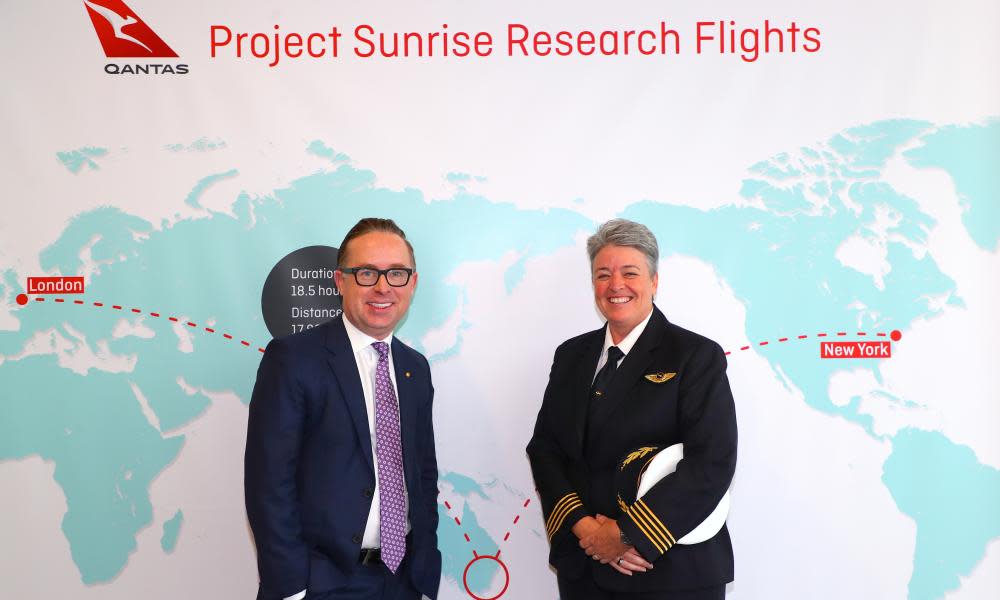Qantas tests 19-hour direct flights from UK and US to Sydney

Qantas is to test non-stop direct flights from London to Sydney to see whether passengers and crew can tolerate what would be the world’s longest commercial flight at 19 hours.
The Australian airline will carry 40 passengers and crew on two flights from New York to Sydney and another from London to Sydney.
The test passengers on the flights this autumn will mainly be Qantas employees, as well as scientists, with no seats sold on the flights. Passengers and crew will be fitted with wearable technology devices to monitor sleep patterns and food and drink consumption, and to see how lighting, physical movement and inflight entertainment impact their health.
Qantas aims to operate regular, non-stop flights to London and New York from Brisbane, Sydney and Melbourne as soon as 2022. The airline will make a decision on whether to introduce the ultra-long routes commercially by the end 2019.
The airline, last year, launched direct flights between London and Perth, on the west coast of Australia, a 17-hour journey. However, the three most populous cities in Australia are all on the country’s east coast, and Melbourne is more than 10,300 miles from New York. London to Sydney is 10,500 miles.
The test flights will use new Boeing 787-9 planes, with fewer passengers and less luggage than usual to extend the range. However, successful test flights would fire the starting gun on a race between the US firm Boeing and its European rival, Airbus, to sell Qantas their new ultra-long-range aircraft, the 777X and the A350 respectively.
The A350 is currently in service on the world’s longest passenger flight: Singapore Airlines’s New York to Singapore slog, which covers 9,500 miles, taking 18 hours and 25 minutes.
The proposed new routes reflect a trend in the airline industry to increase direct, long-distance flights, which are generally preferred by passengers. Alan Joyce, Qantas’s chief executive, said that flying a commercial airliner non-stop from New York to Sydney was “truly the final frontier in aviation”, reflecting the immense distances involved.
Joyce said the start of the commercial flights on the routes was not a “foregone conclusion”, with questions remaining as to whether the routes would be profitable.
“This is ultimately a business decision and the economics have to stack up,” Joyce said.
No commercial airline has ever flown direct from New York to Australia, according to Qantas. It said it flew non-stop from London to Sydney in 1989 to mark the entry into service of the Boeing 747-400 jumbo jet, but with only 23 people on board in order to preserve fuel.
The working patterns and health of crew will be a key determinant of the viability of the routes. Other ultra-long-haul services currently carry multiple crews who operate on four-hour shifts.
Pilots will wear an electroencephalogram (EEG) device to track their brain activity and monitor alertness, so the airline can study the most effective rest pattern. Researchers from Melbourne’s Monash University will also record levels of melatonin – a chemical determining travellers’ experience of jet lag – before, during and after the flights.
Qantas has already used its Perth to London route to test shift patterns. The airline will also test variations on food choices, separate areas for stretching and different entertainment options.
Qantas, Australia’s flag carrier, has operated a service to Britain since 1938, using flying boats made by the UK company Short Brothers. In 1959, Qantas became the first non-American airline to take delivery of jet aircraft that enabled it to reach the US direct. However, until the Perth flight, travellers between the UK and Australia had to stop in airports such as Singapore or, more recently, Dubai.
Modern planes make long-haul flying easier
Aircraft manufacturers are getting better at making cabins habitable for extended periods of time, according to Dr Richard Dawood, a specialist in travel medicine at the Fleet Street Clinic.
Modern planes using carbon-fibre construction can withstand higher air pressure, reducing the uncomfortable feeling of altitude that makes flyers’ ears pop. Humidity can be higher with fewer metal parts, reducing some of the discomfort associated with flying.
Long-haul travel still takes its toll on the body, however. Deep-vein thrombosis (DVT), blood clots that can form particularly in the legs, is one peril. Although it is rare in otherwise healthy people, it has led some airlines to consider allowing more space for passengers to move.
“Sitting in any seat for 19 hours is something that carries an increased risk of thrombosis,” said Dawood. “It would be even more important than normal to get up, move around, stretch.”
There is some evidence that irregular sleeping patterns have a negative effect on the health of shift workers, he added, making monitoring crew health even more important.
There’s also jet lag, but no amount of clever design can prevent changing time zones from disrupting the body’s internal clock. Flying from west to east is worse because the body finds it harder to adapt to a shorter day than a longer one. Scientists are divided as to the effectiveness of melatonin supplements in fighting jet lag, while exposure to bright lights can help the body to adapt.

 Yahoo News
Yahoo News 
